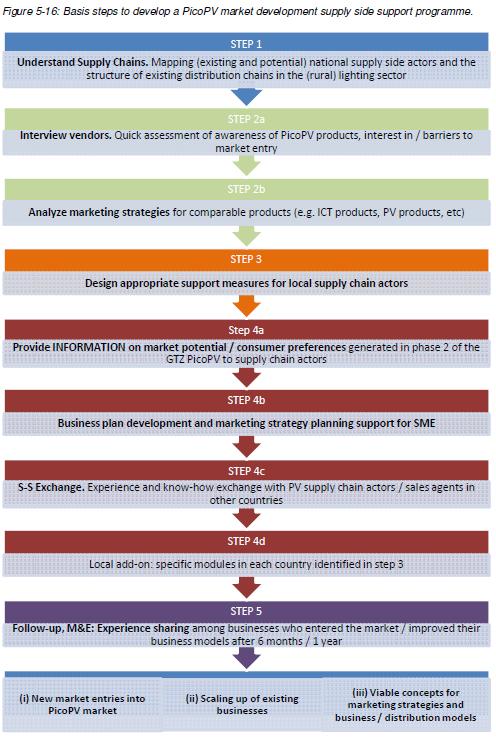Knowledge fuels change - Support energypedia!
For over 10 years, energypedia has been connecting energy experts around the world — helping them share knowledge, learn from each other, and accelerate the global energy transition.
Today, we ask for your support to keep this platform free and accessible to all.
Even a small contribution makes a big difference! If just 10–20% of our 60,000+ monthly visitors donated the equivalent of a cup of coffee — €5 — Energypedia would be fully funded for a whole year.
Is the knowledge you’ve gained through Energypedia this year worth €5 or more?
Your donation keeps the platform running, helps us create new knowledge products, and contributes directly to achieving SDG 7.
Thank you for your support, your donation, big or small, truly matters!
Supply Side Support Activities for PicoPV Market Development
Overview
Support from donors and/or government agencies to (potential) PicoPV supply chain agents operating at national or local levels can be effective and crucial in the initial phases of PicoPV market development. Appropriate and well-designed measures will be needed to trigger the entry of supply chain actors, notably MSME retailers, into PicoPV markets or scaling up of their business. Such support programmes should aim at enabling a multitude of (potential) actors, including MSME, to come up with viable concepts for marketing strategies, distribution and (simple) business models for PicoPV products.
Five Basic Steps
Five basic steps are suggested to develop appropriate support measures on a national level and prioritize concrete activities to help supply chain actors enter and prosper in emerging PicoPV markets.
Basic steps to develop a PicoPV market developnent supply side support programme[1]:
STEP1
In order to understand the possible structures of a domestic PicoPV supply chain, a mapping exercise should be undertaken that takes stock of domestic businesses and existing distribution chains in the (rural) lighting sector: importers, wholesalers, traders, and retailers.
STEP 2
As a next step, the existing state of knowledge and awareness of PicoPV products among business owners identified as potential PicoPV supply chain agents has to be analyzed. In addition marketing strategies for comparable products in the given country or region (e.g. ICT products, PV products, household electronics) should be analyzed in order to identify country specific success factors for market entry and marketing strategies for new technologies. This analysis should help to expand knowledge about ethnic and cultural particularities and demand patterns, especially in the lower income strata, as well as differences between rural, peri-urban and urban settings.
STEP 3
An appropriate national strategy for supply side support for the development of PicoPV markets can be designed on the basis of step 1 and 2 findings. To this end, national, regional and local government and donor structures for business development support should be mapped out, and links to key actors should be established in order to identify possible synergies and alignment to existing structures.
STEP 4
The implementation of this support strategy will be the next step. The following activities may be part of the strategy (but locally appropriate activities may go beyond the initial ideas listed here):
- Information on consumer preferences and market potential for PicoPV products
- Capacity development support for developing business models and concrete concepts for market entry and marketing strategies.
- South-south knowledge exchange
STEP 5
Last but not least, for monitoring and evaluation of the measures taken and in order to identify good practice for PicoPV market development support, follow-up workshops with (emerging) supply chain agents should be organized for sharing of lessons learned, and for identification of remaining hurdles and needs for further support.[2]
Further Information
References
- ↑ GTZ; iiDevelopment. 2009. A Primer on Pico PV Early findings on an emerging low-cost energy technology for developing countries
- ↑ GTZ. 2010. What difference can a PicoPV system make? Early findings on small Photovoltaic systems -an emerging low cost energy technology for developing countries: GIZ PicoPV Booklet




















